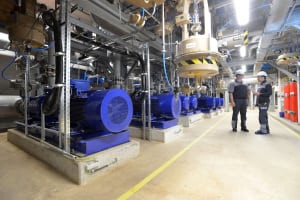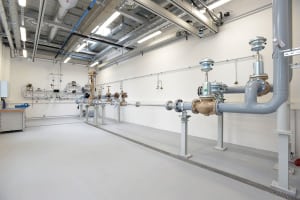 After two years of construction, Samson AG (Frankfurt am Main, Germany; www.samson.de) has opened the Innovation Center — the most modern R&D and test center for valve engineering — on the eastern end of its Frankfurt site. The new, integrated R&D and test center enables all companies within the Samson group to meet the future requirements for testing and R&D activities. At the same time, the facilities of the Innovation Center are open to Samson’s customers and partners for research and certification so that the center can be run at a profit.
After two years of construction, Samson AG (Frankfurt am Main, Germany; www.samson.de) has opened the Innovation Center — the most modern R&D and test center for valve engineering — on the eastern end of its Frankfurt site. The new, integrated R&D and test center enables all companies within the Samson group to meet the future requirements for testing and R&D activities. At the same time, the facilities of the Innovation Center are open to Samson’s customers and partners for research and certification so that the center can be run at a profit.
An area of more than 7,000 m2 is available for prototyping, simulations and a wide variety of tests. New fields in valve R&D, for example data analysis and cloud technologies, are being explored in the Innovation Center in addition to the traditional research topics, such as materials science, flow engineering, cryogenics, acoustics, control engineering, device safety and system integration.
Work in the Innovation Center is focused on the digital transformation of Samson products. Important foundations for this have been laid by equipping the center with complex plant engineering and a sophisticated digital infrastructure. They enable Samson to cover a wide variety of tests, process media, process conditions and fields of application. At the same time, they constitute the ideal base for the research, development and testing of Samson products for all Internet of Things (IoT) and Industry 4.0 environments.
The entire infrastructure, which includes more than 200 test instruments, enables Samson to quickly develop new prime-quality products. These products achieve a high level of reliability in a wide variety of applications already when they are launched onto the market.
Simulations play a key role in the development of new products. Samson has created the perfect environment for the R&D process by bringing together simulations and actual tests. Simulation tools are integrated into the process at an early stage, which gives Samson a deep insight into a product‘s behavior. Further along in the R&D process, a prototype developed largely based on simulations is subjected to real-life functional and wear tests.
As prototyping has also been integrated into the Innovation Center, the economic viability of new products can already be assessed at a very early stage in the development process. It provides essential information for implementation in series production, particularly when designing complex parts. Prototype construction relies on traditional tools machinery, CNC machining centers and increasingly on additive manufacturing methods as well. As a result, the necessary know-how about the latest manufacturing procedures is employed in the development of new products, which lays the foundations for future innovations.
The digital infrastructure and systems installed in the Innovation Center make it possible to perform realtime tests including simulations of various plant and operating conditions. This includes simulations of process media in all possible conditions, such as liquids, gases, vapors, multi-phase flows and even liquids containing solid particles, on different test benches.
This is possible based on the complex plant infrastructure with an installed power of 5.5 MW and more than 250 valves in different sizes and pressure ratings  made by Samson and its subsidiaries. In the Flow Labs, valves in sizes up to DN 500 for pressures up to 120 bars can be subjected to flow, acoustic and functional tests, they can be calibrated and their operation under specific plant conditions can be simulated. Consequently, all flow-relevant coefficients can be determined: they guarantee the proper functioning of the Samson products when handling all media our customers employ.
made by Samson and its subsidiaries. In the Flow Labs, valves in sizes up to DN 500 for pressures up to 120 bars can be subjected to flow, acoustic and functional tests, they can be calibrated and their operation under specific plant conditions can be simulated. Consequently, all flow-relevant coefficients can be determined: they guarantee the proper functioning of the Samson products when handling all media our customers employ.
Special test fields additionally enable us to investigate the devices in their application-specific environment. This includes, for example cold-box applications, which are encountered in air separation systems and involve handling liquid nitrogen at cryogenic temperatures, as well as self-operated regulators for installation in district heating and cooling networks.
Apart from their flow and control properties, an important indicator of the quality that characterizes Samson products is their long service life, even under the most adverse process and ambient conditions. To achieve this durability, individual parts as well as complete control valves are subjected to comprehensive life cycle tests in the Innovation Center. This enables Samson to predict the specific maintenance intervals for different applications.
How long a control valve can withstand the conditions in a plant depends on a number of factors. The tests cover the materials‘ chemical, thermal and mechanical resistance as well as their suitability for specific climate conditions. In addition, the effects of different process and plant conditions, such as cavitation erosion or flow-induced vibration at closure members, must be taken into account. For this purpose, accelerated simulations can be performed on parts and entire devices made of metals and non-metallic materials to test their resistance to the different atmospheric conditions that exist across the world, for example to seawater environments. Further tests to verify corrosion resistance as well as the thermal resistance of materials and compounds are performed in various lab ovens and climatic cabinets by the materials scientists.
The quality of Samson products also becomes evident in how their proper functioning is sustained when their maximum permissible conditions of use are observed. The associated life-cycle coefficients are determined for the different parts using suitable test equipment. The effects that vibrations have on the operation and transport of devices are analyzed. The Flow Labs and their facilities to simulate liquids containing solids are definitely unique. This enables Samson to optimize the ruggedness and wear resistance of our products to meet challenging conditions, as they exist for example in the oil and gas sector or in mining applications.
The focus for Samson’s electrical products lies on device safety and electromagnetic compatibility. As a result, all tests covering the degree of protection, protection against contact, insulations, leads, cables and grounding conductor terminals can be done in the Innovation Center as well. Electromagnetic compatibility testing ensures that the Samson devices work satisfactorily in an electromagnetic environment without causing electromagnetic disturbances that are not acceptable to all other surrounding devices or installations. For this purpose, stations have also been set up to test electrostatic energy and conducted interferences, like they occur when the voltage drops or lightning strikes. Additionally, tests at frequencies up to 18 GHz can be performed in an anechoic chamber for radiated interferences and emission measurements.
Based on these and further inspections completed in the Innovation Center, Samson can document the required compliance of our products with the applicable international standards.
The wide variety of control equipment and sensors installed in the Innovation Center in different sizes and styles enables us to emulate the complexity of our customers‘ plants. The signals transmitted by numerous pumps and control valves are recorded along with other variables, such as pressure, flow rate, temperature, filling level, changes in travel, force, torque, conductivity and noise level. In total, the digital infrastructure comprises approximately 1,700 signals in a networked measuring and automation landscape.
The sensor, control valve and maintenance data collected in the Innovation Center are evaluated, which enables Samson to completely aggregate all data for analysis and visualization. As a result, new approaches for control, monitoring, diagnostic and safety tasks can be implemented. In addition, Samson focuses on developing algorithms for valve diagnostics and the predictive maintenance of control valves, processes, plant sections surrounding the valves and entire plant systems.
Thanks to the communication infrastructure installed throughout the Innovation Center, test data can be archived as usual, but it is also possible to record real-time data through links to cloud computing systems.
Apps to be developed in the future, for example based on Samson’s own SAM DIGITAL HUB platform, will open up new ways of automating process engineering plants.